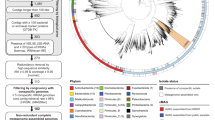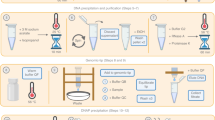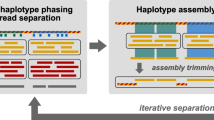Abstract
Although shotgun metagenomic sequencing of microbiome samples enables partial reconstruction of strain-level community structure, obtaining high-quality microbial genome drafts without isolation and culture remains difficult. Here, we present an application of read clouds, short-read sequences tagged with long-range information, to microbiome samples. We present Athena, a de novo assembler that uses read clouds to improve metagenomic assemblies. We applied this approach to sequence stool samples from two healthy individuals and compared it with existing short-read and synthetic long-read metagenomic sequencing techniques. Read-cloud metagenomic sequencing and Athena assembly produced the most comprehensive individual genome drafts with high contiguity (>200-kb N50, fewer than ten contigs), even for bacteria with relatively low (20×) raw short-read-sequence coverage. We also sequenced a complex marine-sediment sample and generated 24 intermediate-quality genome drafts (>70% complete, <10% contaminated), nine of which were complete (>90% complete, <5% contaminated). Our approach allows for culture-free generation of high-quality microbial genome drafts by using a single shotgun experiment.
This is a preview of subscription content, access via your institution
Access options
Access Nature and 54 other Nature Portfolio journals
Get Nature+, our best-value online-access subscription
$29.99 / 30 days
cancel any time
Subscribe to this journal
Receive 12 print issues and online access
$209.00 per year
only $17.42 per issue
Buy this article
- Purchase on Springer Link
- Instant access to full article PDF
Prices may be subject to local taxes which are calculated during checkout






Similar content being viewed by others
Accession codes
References
Schloss, P.D. & Handelsman, J. Metagenomics for studying unculturable microorganisms: cutting the Gordian knot. Genome Biol. 6, 229 (2005).
Turnbaugh, P.J. et al. An obesity-associated gut microbiome with increased capacity for energy harvest. Nature 444, 1027–1031 (2006).
Human Microbiome Project Consortium. Structure, function and diversity of the healthy human microbiome. Nature 486, 207–214 (2012).
Lloyd-Price, J. et al. Strains, functions and dynamics in the expanded Human Microbiome Project. Nature 550, 61–66 (2017).
Kashtan, N. et al. Single-cell genomics reveals hundreds of coexisting subpopulations in wild Prochlorococcus. Science 344, 416–420 (2014).
Baker, B.J., Lazar, C.S., Teske, A.P. & Dick, G.J. Genomic resolution of linkages in carbon, nitrogen, and sulfur cycling among widespread estuary sediment bacteria. Microbiome 3, 14 (2015).
Eyice, Ö. et al. SIP metagenomics identifies uncultivated Methylophilaceae as dimethylsulphide degrading bacteria in soil and lake sediment. ISME J. 9, 2336–2348 (2015).
He, Y. et al. Genomic and enzymatic evidence for acetogenesis among multiple lineages of the archaeal phylum Bathyarchaeota widespread in marine sediments. Nat. Microbiol. 1, 16035 (2016).
Brown, C.T. et al. Unusual biology across a group comprising more than 15% of domain bacteria. Nature 523, 208–211 (2015).
Hug, L.A. et al. A new view of the tree of life. Nat. Microbiol. 1, 16048 (2016).
O'Leary, N.A. et al. Reference sequence (RefSeq) database at NCBI: current status, taxonomic expansion, and functional annotation. Nucleic Acids Res. 44, D733–D745 (2016).
Peng, Y., Leung, H.C.M., Yiu, S.M. & Chin, F.Y.L. IDBA-UD: a de novo assembler for single-cell and metagenomic sequencing data with highly uneven depth. Bioinformatics 28, 1420–1428 (2012).
Namiki, T., Hachiya, T., Tanaka, H. & Sakakibara, Y. MetaVelvet: an extension of Velvet assembler to de novo metagenome assembly from short sequence reads. Nucleic Acids Res. 40, e155 (2012).
Cleary, B. et al. Detection of low-abundance bacterial strains in metagenomic datasets by eigengenome partitioning. Nat. Biotechnol. 33, 1053–1060 (2015).
Wu, Y.-W., Tang, Y.-H., Tringe, S.G., Simmons, B.A. & Singer, S.W. MaxBin: an automated binning method to recover individual genomes from metagenomes using an expectation-maximization algorithm. Microbiome 2, 26 (2014).
Kang, D.D., Froula, J., Egan, R. & Wang, Z. MetaBAT, an efficient tool for accurately reconstructing single genomes from complex microbial communities. PeerJ 3, e1165 (2015).
Nielsen, H.B. et al. Identification and assembly of genomes and genetic elements in complex metagenomic samples without using reference genomes. Nat. Biotechnol. 32, 822–828 (2014).
Alneberg, J. et al. Binning metagenomic contigs by coverage and composition. Nat. Methods 11, 1144–1146 (2014).
Popic, V., Kuleshov, V., Snyder, M. & Batzoglou, S. GATTACA: lightweight metagenomic binning with compact indexing of kmer counts and minhash-based panel selection. Preprint at https://www.biorxiv.org/content/early/2017/04/26/130997 (2017).
Koren, S. et al. Hybrid error correction and de novo assembly of single-molecule sequencing reads. Nat. Biotechnol. 30, 693–700 (2012).
Chin, C.-S. Nonhybrid, finished microbial genome assemblies from long-read SMRT sequencing data. Nat. Methods 10, 563–569 (2013).
Loman, N.J., Quick, J. & Simpson, J.T. A complete bacterial genome assembled de novo using only nanopore sequencing data. Nat. Methods 12, 733–735 (2015).
Leonard, M.T. et al. The methylome of the gut microbiome: disparate Dam methylation patterns in intestinal Bacteroides dorei. Front. Microbiol. 5, 361 (2014).
Voskoboynik, A. et al. The genome sequence of the colonial chordate, Botryllus schlosseri. eLife 2, e00569 (2013).
Kuleshov, V. et al. Synthetic long-read sequencing reveals intraspecies diversity in the human microbiome. Nat. Biotechnol. 34, 64–69 (2016).
Sharon, I. et al. Accurate, multi-kb reads resolve complex populations and detect rare microorganisms. Genome Res. 25, 534–543 (2015).
White, R.A. III et al. Moleculo long-read sequencing facilitates assembly and genomic binning from complex soil metagenomes. mSystems 1, e00045–16 (2016).
Zheng, G.X.Y. et al. Haplotyping germline and cancer genomes with high-throughput linked-read sequencing. Nat. Biotechnol. 34, 303–311 (2016).
Bishara, A. et al. Read clouds uncover variation in complex regions of the human genome. Genome Res. 25, 1570–1580 (2015).
Peters, B.A. et al. Accurate whole-genome sequencing and haplotyping from 10 to 20 human cells. Nature 487, 190–195 (2012).
Kitzman, J.O. et al. Haplotype-resolved genome sequencing of a Gujarati Indian individual. Nat. Biotechnol. 29, 59–63 (2011).
Amini, S. et al. Haplotype-resolved whole-genome sequencing by contiguity-preserving transposition and combinatorial indexing. Nat. Genet. 46, 1343–1349 (2014).
Spies, N. et al. Genome-wide reconstruction of complex structural variants using read clouds. Nat. Methods 14, 915–920 (2017).
Lin, Y. et al. Assembly of long error-prone reads using de Bruijn graphs. Proc. Natl. Acad. Sci. USA 113, E8396–E8405 (2016).
Kolmogorov, M., Yuan, J., Lin, Y. & Pevzner, P. Assembly of long error-prone reads using repeat graphs. Preprint at https://www.biorxiv.org/content/early/2018/01/12/247148 (2018).
Mikheenko, A., Saveliev, V. & Gurevich, A. MetaQUAST: evaluation of metagenome assemblies. Bioinformatics 32, 1088–1090 (2016).
Parks, D.H., Imelfort, M., Skennerton, C.T., Hugenholtz, P. & Tyson, G.W. CheckM: assessing the quality of microbial genomes recovered from isolates, single cells, and metagenomes. Genome Res. 25, 1043–1055 (2015).
Bowers, R.M. et al. Minimum information about a single amplified genome (MISAG) and a metagenome-assembled genome (MIMAG) of bacteria and archaea. Nat. Biotechnol. 35, 725–731 (2017).
Martin, M. Cutadapt removes adapter sequences from high-throughput sequencing reads. EMBnet.journal 17, 10–12 (2011).
Bankevich, A. et al. SPAdes: A new genome assembly algorithm and its applications to single-cell sequencing. J. Comput. Biol. 19, 455–477 (2012).
Bankevich, A. & Pevzner, P.A. TruSPAdes: barcode assembly of TruSeq synthetic long reads. Nat. Methods 13, 248–250 (2016).
Koren, S. et al. Canu: scalable and accurate long-read assembly via adaptive k-mer weighting and repeat separation. Genome Res. 27, 722–736 (2017).
Li, D., Liu, C.-M., Luo, R., Sadakane, K. & Lam, T.-W. MEGAHIT: an ultra-fast single-node solution for large and complex metagenomics assembly via succinct de Bruijn graph. Bioinformatics 31, 1674–1676 (2015).
Li, H. & Durbin, R. Fast and accurate short read alignment with Burrows-Wheeler transform. Bioinformatics 25, 1754–1760 (2009).
Seemann, T. Prokka: rapid prokaryotic genome annotation. Bioinformatics 30, 2068–2069 (2014).
Laslett, D. & Canback, B. ARAGORN, a program to detect tRNA genes and tmRNA genes in nucleotide sequences. Nucleic Acids Res. 32, 11–16 (2004).
Seemann, T. barrnap. Github https://github.com/tseemann/barrnap/ (2018).
Wood, D.E. & Salzberg, S.L. Kraken: ultrafast metagenomic sequence classification using exact alignments. Genome Biol. 15, R46 (2014).
Benson, D.A. et al. GenBank. Nucleic Acids Res. 41, D36–D42 (2013).
Acknowledgements
The authors thank E. Tkachenko for assistance in preparing TruSeq libraries and M. Snyder and members of the laboratory of A.S.B. for helpful feedback. The authors also thank H. Xu at Illumina for sharing read-cloud sequencing data of ATCC 20 for the mock metagenome. This work was supported by NCI K08 CA184420, the Amy Strelzer Manasevit Award from the National Marrow Donor Program, and a Damon Runyon Clinical Investigator Award to A.S.B. E.L.M. was supported by National Science Foundation Graduate Research Fellowship DGE-114747. A.B. was supported by the Stanford Genome Training Program (SGTP; NIH/NHGRI) and a Training Grant of the Joint Initiative for Metrology in Biology (JIMB; NIST). A.E.D. and the marine-sample collection and extraction were supported by National Science Foundation grant OCE-1634297. A.E.P. was supported by a Center for Dark Energy Biosphere Investigations Postdoctoral Fellowship. Access to shared computer resources was supported in part by NIH P30 CA124435 via the Stanford Cancer Institute Shared Resource Genetics Bioinformatics Service Center.
Author information
Authors and Affiliations
Contributions
A.B., E.L.M., A.S.B. and S.B. conceived the study. Z.W. prepared read-cloud libraries. E.L.M. extracted DNA and prepared SLR sequencing libraries. E.L.M. performed PCR validation and Sanger sequencing. A.B. and S.B. conceived the assembly approach. A.B. implemented the Athena assembler. M.K. modified the Flye assembler for use with Athena. A.E.P. and A.E.D. collected the marine-sediment sample, extracted DNA from the marine-sediment sample and assisted in analysis of these samples. A.B., A.S.B. and E.L.M. carried out all analyses, wrote the manuscript, and generated figures. All authors commented on the manuscript.
Corresponding authors
Ethics declarations
Competing interests
S.B. is an employee of and owns stock in Illumina. Shotgun sequencing products developed, marketed and/or sold by Illumina were used in this work.
Supplementary information
Supplementary Text and Figures
Supplementary Figures 1–5, Supplementary Tables 1, 3, 4, and Supplementary Notes 1–8 (PDF 5546 kb)
Supplementary Table 2
Per-species MetaQUAST statistics for ATCC 20 (XLSX 40 kb)
Supplementary Table 5
Assignment of metagenomic contigs to bins for healthy gut samples (TXT 1592 kb)
Supplementary Table 6
Per-taxon genome bin statistics for healthy gut samples (CSV 10 kb)
Supplementary Table 7
Comparisons of healthy gut genome bins and available references (XLSX 9 kb)
Supplementary Table 8
Assignment of metagenomic contigs to bins for marine sediment sample (TXT 6609 kb)
Supplementary Table 9
Genome bin statistics for marine sample (CSV 5 kb)
Supplementary Table 10
High-copy repeat statistics for P. copri (XLSX 7 kb)
Supplementary Table 11
Per-species MetaQUAST statistics for in silico downsampled ATCC 20 (XLSX 37 kb)
Supplementary Table 12
Per-taxon genome bin statistics for in silico downsampled human gut sample (CSV 3 kb)
Rights and permissions
About this article
Cite this article
Bishara, A., Moss, E., Kolmogorov, M. et al. High-quality genome sequences of uncultured microbes by assembly of read clouds. Nat Biotechnol 36, 1067–1075 (2018). https://doi.org/10.1038/nbt.4266
Received:
Accepted:
Published:
Issue Date:
DOI: https://doi.org/10.1038/nbt.4266
This article is cited by
-
Ariadne: synthetic long read deconvolution using assembly graphs
Genome Biology (2023)
-
Maast: genotyping thousands of microbial strains efficiently
Genome Biology (2023)
-
A high-quality genome compendium of the human gut microbiome of Inner Mongolians
Nature Microbiology (2023)
-
Viruses interact with hosts that span distantly related microbial domains in dense hydrothermal mats
Nature Microbiology (2023)
-
Target-enriched long-read sequencing (TELSeq) contextualizes antimicrobial resistance genes in metagenomes
Microbiome (2022)



